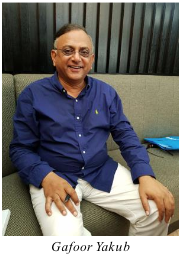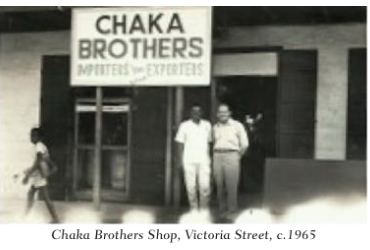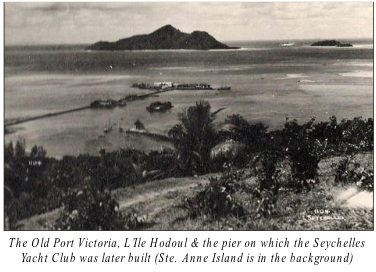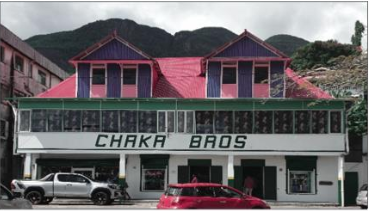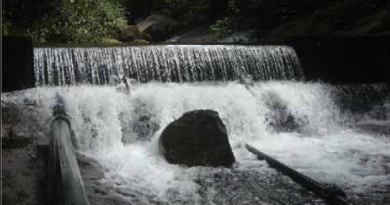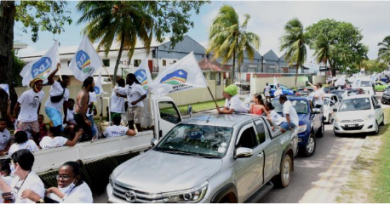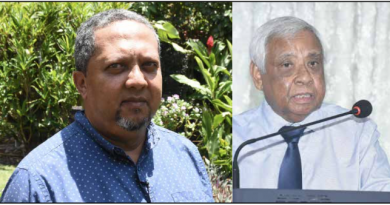The Chaka Family: Celebrating over 100 Years of Livelihood in Seychelles, 1918-2020
Considered as one of Victoria’s landmark, the Chaka building which was constructed in 1920, marks its 100th anniversary this year. Sometime ago, the Seychelles Heritage Foundation put up a ‘1920’ date plaque on the front wall of the Chaka shop in recognition of the traditional style building as a cultural heritage site.
In terms of historical background, Mr. Gafoor Yakub Chaka of the Chaka Brothers family shop recollects the following: “My grandparents got married very young in a village in the district of Baroda, State of Gujarat, India. Getting married young was common practice at the time. Baroda was the second biggest city occupied by the British, second afterBombay (now renamed Mumbai). My grandparents emigrated from Bombay to Seychelles in 1918 by merchant ship belonging to the British India Steam Navigation Co. Ltd.”“My grandfather actually came to assist his maternal uncle, Adam Moosa, in running his vast business operations which ranged from import-export-wholesale-retail to supplying most of the inner and outer islands. I believe my grandfather developed a keen eye for investment in real estate and property development during his relatively short life span in Seychelles. He bought a lot of properties for the Adam Moosa Company, including the Chaka Building. He also was responsible for recruiting several staff on short-term contracts from his village in India as the company operations in Seychelles expanded in the 1930s, 1940s and beyond.”“The Chaka building was built in 1920, and my grandfather was instrumental in purchasing it. Because my grandfather worked with Adam Moosa (c.1878-1928) and had a 25% shareholding in the business, I think my grandfather owned this building as part of his share. And over the years he literally brought up his entire family of 10 children in that building.”
“The Chaka building is located on Francis Rachel Street, which was then called Victoria Street that led to the Clock Tower and then from the Clock Tower there was a narrow seafront street that led straight to the old port harbour where the ships would berth. On the other side of Victoria Street there was an esplanade where Nouvobanq & SACOS are currently located. The esplanade was full of greenery, hedges and majestic sandragon trees providing shade to the passers-by. While one side of L’esplanade bordered onto Victoria Street, the other side of the walkway bordered onto the open sea i.e. the Indian Ocean. I recall from the edge of the sea front, there were some old steps leading up to the esplanade area. As a youngster, I remember the smaller outboard boats from Ste Anne, Round, Moyenne and Cerf islands would come and berth near there to buy their provisions from Chaka Brothers, Adam Moosa, Teemooljee, Jivan and so on,” Mr. Yakub recounts.
Gafoor Yakub “In the olden days gone by, the main road was Victoria Street and this led to another main road, Albert Street. Albert Street is one of the very few streets that never changed its name after the coup d’état and we all know why. The people need to know it was actually named after Prince Albert, not after our former President Albert Rene.”
From the year 1900 up to the mid-1970s, Victoria Street found itself as the commercial centre of town since most people procured their groceries and got their repairs done from the variety of retail and repair shops located in the capital, Victoria. Seychelles’ top exports—cup copra, cinnamon bark, patchouli, vanilla, and guano—were also purchased and delivered there by the landowners and occasionally some export goods were stored at a large warehouse located at the old Victoria Port jetty for subsequent fumigation, loading and shipment to Europe and Asia. Victoria Street itself was initially a rough road; it was not tarmacked or surfaced until after the Second World War, 1939-1945.
The Chaka family were not the only immigrants of Indian origin from Gujarat who focussed on trade and commerce and who built their homes and businesses on Victoria Street. The Adam Moosa family, Hassanali & Umarjis, Udwadias, Khambattas, Dhanjees, Oliajis, Pardiwallas, and Jivans all owned properties along Victoria Street, from Le Chantier down to the Clock Tower. There was a good mix of Hindu, Muslim and Parsee (Zorastrian) families that settled there and they somehow integrated and mixed well with their Christian neighbours. It’s interesting that the modest but well-known Alibhaye family who arrived in 1890 from Sarod, another village of Gujarat in India somehow chose to settle at Anse Royale where they still operate a retail shop and own a few fishing boats. They have always been keen on fishing, integrating well with the locals. Like the Chakas, many of these families arrived in Seychelles from the late 1800s to early 1900s in search of a better life as well as adventure. In those days in India, then a British colony, there were newspaper adverts published by the British India (B.I.) Steam Navigation company enticing people from abroad to emigrate and to “Visit exotic Seychelles byB.I. with a monthly sailing from Bombay and Durban”.
Gafoor Yakub’s grandfather, Mohamed Adam Chaka, first set foot in Seychelles in 1918 just after the First World War at the tender age of 16, accompanied by his equally young wife, Fullibhai—Seychelles was a place he would call home until his death on 14th February 1944. The couple had 10 children, 5 sons and 5 daughters—the first generation of Chakas, born and bred in Seychelles.
“The shop of Chaka Brothers started operating in 1965, and it was my late father, Yakub Chaka, who founded it. He got his four other brothers to join him while he ensured that his 5 sisters each got married eventually. Incidentally, the sisters all got married and settled in certain countries on the African continent.”
“When my grandfather passed away suddenly in 1944, my own father had to be removed from the Marist-run Catholic school at 14 years old as my grandmother, who had no knowledge of business, felt she could not afford the school fees. My father was sent abroad for a number of years for his academic studies. He then came back to work at Adam Moosa as a Clerk, and he subsequently got married to one of the daughters of Suleman Adam Moosa, the only son of Adam Moosa.”
“By the age of 35 my father wanted his independence; that is when he opened a shop on the ground floor of the Chaka building while residing upstairs with his wife and family of 9 children. It is part of his legacy that the import-export-wholesale and retail business that he started since 1965 is still in operation for 55 years to date.” Chaka Brothers is still doing business.
As told by Gafoor Yakub
